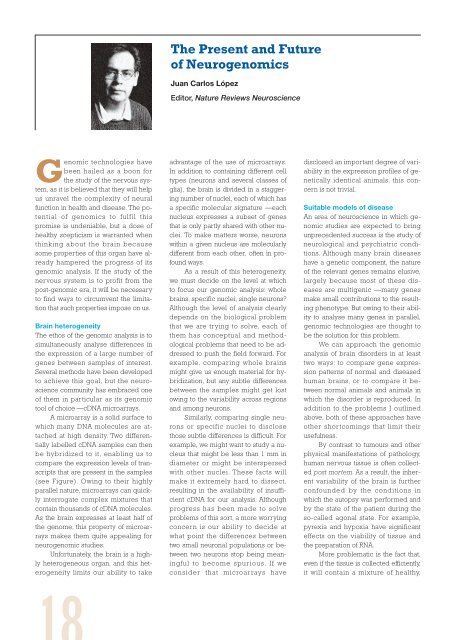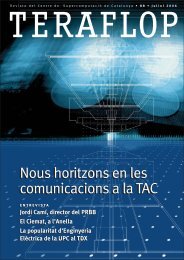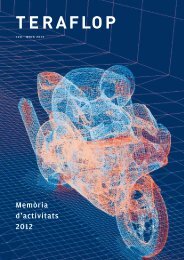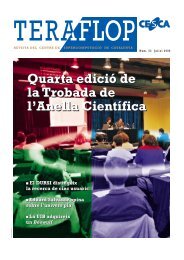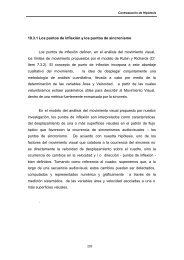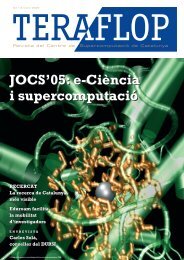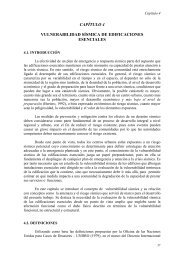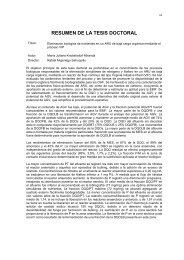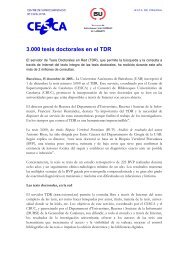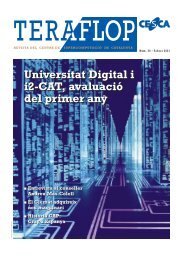Teraflop 73 - Novembre - cesca
Teraflop 73 - Novembre - cesca
Teraflop 73 - Novembre - cesca
You also want an ePaper? Increase the reach of your titles
YUMPU automatically turns print PDFs into web optimized ePapers that Google loves.
Genomic technologies have<br />
been hailed as a boon for<br />
the study of the nervous system,<br />
as it is believed that they will help<br />
us unravel the complexity of neural<br />
function in health and disease. The potential<br />
of genomics to fulfil this<br />
promise is undeniable, but a dose of<br />
healthy scepticism is warranted when<br />
thinking about the brain because<br />
some properties of this organ have already<br />
hampered the progress of its<br />
genomic analysis. If the study of the<br />
nervous system is to profit from the<br />
post-genomic era, it will be necessary<br />
to find ways to circumvent the limitation<br />
that such properties impose on us.<br />
Brain heterogeneity<br />
The ethos of the genomic analysis is to<br />
simultaneously analyse differences in<br />
the expression of a large number of<br />
genes between samples of interest.<br />
Several methods have been developed<br />
to achieve this goal, but the neuroscience<br />
community has embraced one<br />
of them in particular as its genomic<br />
tool of choice —cDNA microarrays.<br />
A microarray is a solid surface to<br />
which many DNA molecules are attached<br />
at high density. Two differentially<br />
labelled cDNA samples can then<br />
be hybridized to it, enabling us to<br />
compare the expression levels of transcripts<br />
that are present in the samples<br />
(see Figure). Owing to their highly<br />
parallel nature, microarrays can quickly<br />
interrogate complex mixtures that<br />
contain thousands of cDNA molecules.<br />
As the brain expresses at least half of<br />
the genome, this property of microarrays<br />
makes them quite appealing for<br />
neurogenomic studies.<br />
Unfortunately, the brain is a highly<br />
heterogeneous organ, and this heterogeneity<br />
limits our ability to take<br />
The Present and Future<br />
of Neurogenomics<br />
Juan Carlos López<br />
Editor, Nature Reviews Neuroscience<br />
advantage of the use of microarrays.<br />
In addition to containing different cell<br />
types (neurons and several classes of<br />
glia), the brain is divided in a staggering<br />
number of nuclei, each of which has<br />
a specific molecular signature —each<br />
nucleus expresses a subset of genes<br />
that is only partly shared with other nuclei.<br />
To make matters worse, neurons<br />
within a given nucleus are molecularly<br />
different from each other, often in profound<br />
ways.<br />
As a result of this heterogeneity,<br />
we must decide on the level at which<br />
to focus our genomic analysis: whole<br />
brains, specific nuclei, single neurons?<br />
Although the level of analysis clearly<br />
depends on the biological problem<br />
that we are trying to solve, each of<br />
them has conceptual and methodological<br />
problems that need to be addressed<br />
to push the field forward. For<br />
example, comparing whole brains<br />
might give us enough material for hybridization,<br />
but any subtle differences<br />
between the samples might get lost<br />
owing to the variability across regions<br />
and among neurons.<br />
Similarly, comparing single neurons<br />
or specific nuclei to disclose<br />
those subtle differences is difficult. For<br />
example, we might want to study a nucleus<br />
that might be less than 1 mm in<br />
diameter or might be interspersed<br />
with other nuclei. These facts will<br />
make it extremely hard to dissect,<br />
resulting in the availability of insufficient<br />
cDNA for our analysis. Although<br />
progress has been made to solve<br />
problems of this sort, a more worrying<br />
concern is our ability to decide at<br />
what point the differences between<br />
two small neuronal populations or between<br />
two neurons stop being meaningful<br />
to become spurious. If we<br />
consider that microarrays have<br />
disclosed an important degree of variability<br />
in the expression profiles of genetically<br />
identical animals, this concern<br />
is not trivial.<br />
Suitable models of disease<br />
An area of neuroscience in which genomic<br />
studies are expected to bring<br />
unprecedented success is the study of<br />
neurological and psychiatric conditions.<br />
Although many brain diseases<br />
have a genetic component, the nature<br />
of the relevant genes remains elusive,<br />
largely because most of these diseases<br />
are multigenic —many genes<br />
make small contributions to the resulting<br />
phenotype. But owing to their ability<br />
to analyse many genes in parallel,<br />
genomic technologies are thought to<br />
be the solution for this problem.<br />
We can approach the genomic<br />
analysis of brain disorders in at least<br />
two ways: to compare gene expression<br />
patterns of normal and diseased<br />
human brains, or to compare it between<br />
normal animals and animals in<br />
which the disorder is reproduced. In<br />
addition to the problems I outlined<br />
above, both of these approaches have<br />
other shortcomings that limit their<br />
usefulness.<br />
By contrast to tumours and other<br />
physical manifestations of pathology,<br />
human nervous tissue is often collected<br />
post mortem.As a result, the inherent<br />
variability of the brain is further<br />
confounded by the conditions in<br />
which the autopsy was performed and<br />
by the state of the patient during the<br />
so-called agonal state. For example,<br />
pyrexia and hypoxia have significant<br />
effects on the viability of tissue and<br />
the preparation of RNA.<br />
More problematic is the fact that,<br />
even if the tissue is collected efficiently,<br />
it will contain a mixture of healthy,


